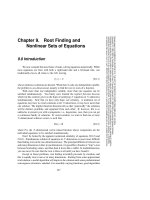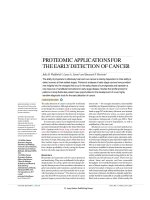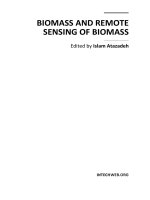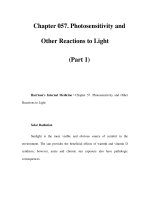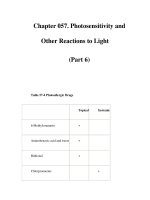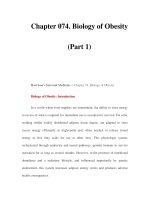Chapter 078. Prevention and Early Detection of Cancer (Part 1) pps
Bạn đang xem bản rút gọn của tài liệu. Xem và tải ngay bản đầy đủ của tài liệu tại đây (11.83 KB, 5 trang )
Chapter 078. Prevention and Early
Detection of Cancer
(Part 1)
Harrison's Internal Medicine > Chapter 78. Prevention and Early
Detection of Cancer
Prevention and Early Detection of Cancer: Introduction
Improved understanding of carcinogenesis has allowed cancer prevention
and early detection (also known as cancer control) to expand beyond the
identification and avoidance of carcinogens. Specific interventions to prevent
cancer in those at risk, and more sensitive and specific screening for early
detection of cancer are the goals.
Carcinogenesis is not simply an event but a process, a continuum of
discrete cellular changes over time resulting in more autonomous cellular
processes. Prevention concerns the identification and manipulation of the genetic,
biologic, and environmental factors in the causal pathway of cancer.
Education and Healthful Habits
Public education on the avoidance of identified risk factors for cancer and
encouraging healthy habits contributes to cancer prevention and control. The
physician is a powerful messenger in this education campaign. The patient-
physician encounter provides an opportunity to teach patients about the hazards of
smoking, the features of a healthy lifestyle (including diet and exercise), use of
proven cancer screening methods, and sun avoidance.
Smoking Cessation
Tobacco smoking is the most modifiable risk factor for cardiovascular
disease, pulmonary disease, and cancer. Smokers have a 33% lifetime risk of
dying prematurely from a tobacco-related cancer, cardiovascular, or pulmonary
disease. Tobacco use causes more deaths from cardiovascular disease than from
cancer. Lung cancer and cancers of the larynx, oropharynx, esophagus, kidney,
bladder, pancreas, and stomach are all tobacco-related.
The degree of smoke exposure, meaning the number of cigarettes smoked
per day as well as the level of inhalation of cigarette smoke, is correlated with risk
of lung cancer mortality. Light- and low-tar cigarettes are not safer because
smokers tend to inhale them more frequently and deeply.
Those who stop smoking have a 30–50% lower 10-year lung cancer
mortality rate compared to those who continue smoking, despite the fact that some
carcinogen-induced gene mutations persist for years after smoking cessation.
Smoking cessation and avoidance have the potential to save more lives than any
other public health activity.
The risk of tobacco smoke is not limited to the smoker. Environmental
tobacco smoke, known as second hand or passive smoke, causes lung cancer and
other cardiopulmonary diseases in nonsmokers.
Tobacco prevention is a pediatric issue. Over 80% of adult American
smokers began smoking before the age of 18. Nearly 20% of Americans aged 12–
18 have smoked a cigarette in the past month. Counseling of adolescents and
young adults is critical to prevent smoking. A physician's simple advice to not start
smoking or to quit smoking can be of benefit. Physicians should query patients on
tobacco use on every office visit, record the answer with the vital signs, and ask
smokers if they would like assistance in quitting.
Current approaches to smoking cessation recognize that smoking is an
addiction (Chap. 390). The smoker who is quitting goes through a process with
identifiable stages that include contemplation of quitting, an action phase in which
the smoker quits, and a maintenance phase. Smokers who quit completely are
more likely to be successful than those who gradually reduce the number of
cigarettes smoked or change to lower tar or nicotine cigarettes. More than 90% of
the Americans who have successfully quit smoking did so on their own without
participation in an organized cessation program, but cessation programs are
helpful for some smokers. The Community Intervention Trial for Smoking
Cessation (COMMIT) was a 4-year program; it demonstrated that light smokers
(<25 cigarettes per day) were more likely to benefit from simple cessation
messages and cessation programs. Quit rates were 30.6% in the intervention group
and 27.5% in the control group. The COMMIT interventions were not successful
in heavy smokers (>25 cigarettes per day). Heavy smokers may need an intensive
broad-based cessation program that includes counseling, behavioral strategies, and
pharmacologic adjuncts, such as nicotine replacement (gum, patches, sprays,
lozenges, and inhalers) and bupropion.
Cigar smoking has increased in the past decade. The health risks of cigars
are similar to those of cigarettes. Smoking one or two cigars daily doubles the risk
for oral and esophageal cancers; three or four cigars daily increases the risk of oral
cancers more than eightfold and esophageal cancer fourfold. The risks of
occasional use are unknown.
Smokeless tobacco is the fastest growing part of the tobacco industry and
represents a substantial health risk. Chewing tobacco is a carcinogen linked to
dental caries, gingivitis, oral leukoplakia, and oral cancer. The systemic effects of
smokeless tobacco may increase risks for other cancers. Esophageal cancer is
linked to carcinogens in tobacco being dissolved in saliva, swallowed, and coming
into contact with the esophagus.
